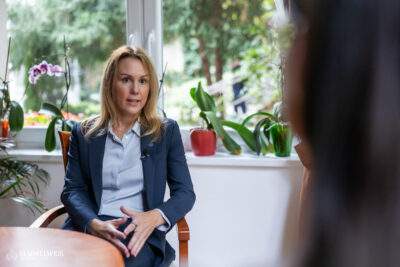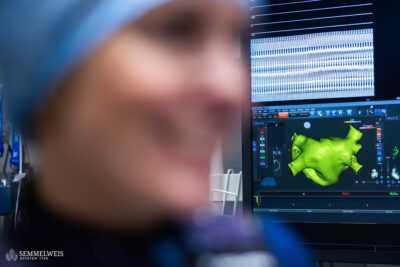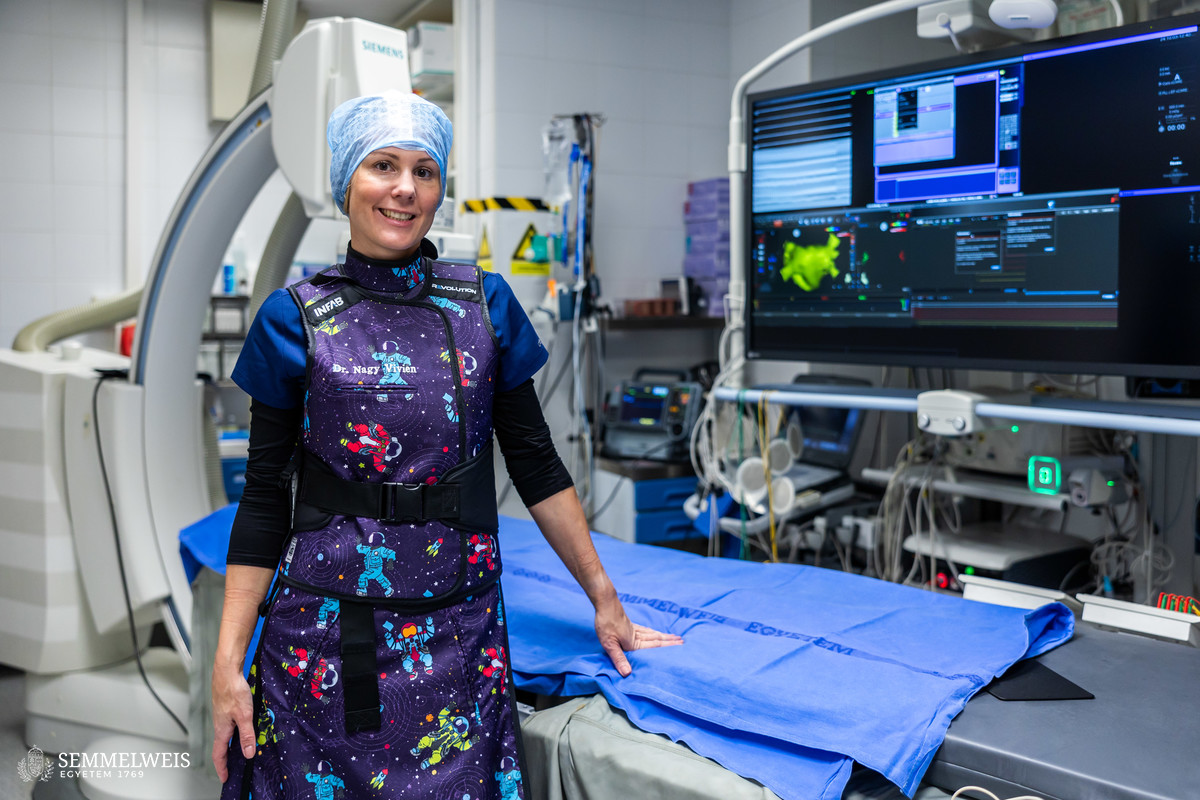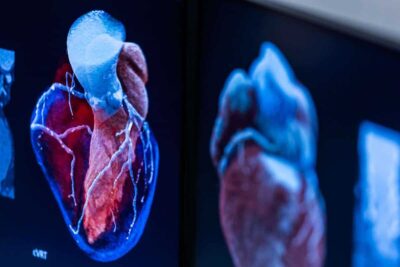“I have been interested in space-related things since childhood, including movies: I was a big Star Wars fan. I got to HUNOR thanks to a very lucky coincidence,” Dr. Klaudia Vivien Nagy told our website. “I graduated from Semmelweis University in 2011, and since then I have been working here at the Városmajor Heart and Vascular Center, where I have completed my PhD and became a cardiologist. Within that, I specialize in electrophysiology, which is basically a treatment for irregular heartbeats using catheters. I am also engaged in policy-making, I have completed a Health Economics correspondence MSc at the London School of Economics and Political Sciences, and I am involved in Hungarian and international policy-making organizations in the field of cardiology, such as the cardiology division of the College of Healthcare Professionals and various bodies of the European Society of Cardiology. I also have experience in providing medical assistance at sporting events. In 2022, the representatives of the HUNOR Program invited Semmelweis University to contribute to the medical and healthcare part of the space program. Rector Dr. Béla Merkely is in charge of the project and has assigned me as his direct colleague to carry out the operational tasks. When I heard that this was a space program, at first, I thought I had got it wrong, but of course, I said yes without hesitation,” the assistant professor recalled.
As an affiliated healthcare and research institution contributing to the HUNOR Astronaut Program, Semmelweis University is involved in the Selection and Training sub-program, and leads, develops, coordinates, and operates the medical part of the Research sub-program. Dr. Béla Merkely is responsible for the medical expert tasks within the HUNOR Program’s Steering Board.
In the summer of 2022, following the pre-selection of more than 240 applicants, Semmelweis University shortlisted the top 8 astronaut candidates from 25 individuals based on their medical fitness after having developed a protocol that incorporated ESA (European Space Agency) and NASA guidelines. This included specialist examinations in ophthalmology, dentistry, ENT, cardiology, psychology-psychiatry, and gastroenterology, among others. As a result, almost all clinics of the university took part in the project, in addition to the Department of Aviation and Space Medicine led by the rector. Dr. Klaudia Vivien Nagy explained that they wanted to add their own know-how to the existing protocols, so they also performed several additional screening tests, such as cardiac MR and blood clotting tests. The astronauts also received training in telemedicine and resuscitation at the Városmajor Heart and Vascular Center. (Read more about the astronaut training here.) The assistant professor emphasized that the medical results of the four Hungarian astronaut candidates had been approved by the ESA, so they had also received a European-wide accepted medical certificate, based on the examinations performed at Semmelweis University. At the end of the selection process, Tibor Kapu was chosen to take part in the 2025 mission as a Hungarian research astronaut and his backup will be Gyula Cserényi. The two of them are currently undergoing mission-specific training in Houston, USA.
 After the selection process, the Hungarian physician was contacted by ESA’s medical director to join their medical team and became a flight surgeon candidate, Dr. Klaudia Vivien Nagy explained. “The 1.5-year training has theoretical and practical components and involves a lot of traveling. ESA is headquartered in Cologne, where half of the training courses took place, while the other half was in Houston. Here I took part in a mission similar to the one that the Hungarian astronaut is preparing for, so it was a useful professional experience: A Danish astronaut was on the space station for six months, and I was monitoring their mission as a flight surgeon in training from the Houston center,” she added. She completed her training and received her ESA diploma in space medicine on September 26.
After the selection process, the Hungarian physician was contacted by ESA’s medical director to join their medical team and became a flight surgeon candidate, Dr. Klaudia Vivien Nagy explained. “The 1.5-year training has theoretical and practical components and involves a lot of traveling. ESA is headquartered in Cologne, where half of the training courses took place, while the other half was in Houston. Here I took part in a mission similar to the one that the Hungarian astronaut is preparing for, so it was a useful professional experience: A Danish astronaut was on the space station for six months, and I was monitoring their mission as a flight surgeon in training from the Houston center,” she added. She completed her training and received her ESA diploma in space medicine on September 26.
 The flight surgeons do not accompany the astronauts into space, but rather monitor the entire mission from Earth, and perform several tasks before and after the mission: Firstly, they need to have the most up-to-date information on all health parameters of the astronauts. A two-week quarantine precedes the launch, as any infectious disease would have severe consequences on the space mission. Dr. Klaudia Vivien Nagy explained that the flight surgeon was with the astronaut all the time throughout the quarantine. On the day of the rocket launch, the astronauts put on a specialized pressure suit, also known as the space suit, at the Kennedy Space Center. Then they travel by car, accompanied by their flight surgeon, to the launch pad, where they are escorted by the flight surgeon to the entrance of the capsule. While the astronaut is on the space station, their doctor monitors their activity from the ground operations center, and they can also communicate regularly, every day after arrival and then weekly, depending on the length of the mission. Should there be a medical question, problem, or emergency, the astronaut can reach their physician immediately, and there is always a physician in the Houston control center, following NASA’s official duty roster.
The flight surgeons do not accompany the astronauts into space, but rather monitor the entire mission from Earth, and perform several tasks before and after the mission: Firstly, they need to have the most up-to-date information on all health parameters of the astronauts. A two-week quarantine precedes the launch, as any infectious disease would have severe consequences on the space mission. Dr. Klaudia Vivien Nagy explained that the flight surgeon was with the astronaut all the time throughout the quarantine. On the day of the rocket launch, the astronauts put on a specialized pressure suit, also known as the space suit, at the Kennedy Space Center. Then they travel by car, accompanied by their flight surgeon, to the launch pad, where they are escorted by the flight surgeon to the entrance of the capsule. While the astronaut is on the space station, their doctor monitors their activity from the ground operations center, and they can also communicate regularly, every day after arrival and then weekly, depending on the length of the mission. Should there be a medical question, problem, or emergency, the astronaut can reach their physician immediately, and there is always a physician in the Houston control center, following NASA’s official duty roster.
At the end of the missions, the space capsules splashdown in the ocean off the coast of Florida, where the astronauts are recovered by marines and immediately taken into the care of doctors to undergo the necessary examinations. After returning by helicopter to shore and then by plane to Houston, the rehabilitation process follows, which takes 4-6 weeks for a six-month mission. There are different phases of rehabilitation: First, the circulation and the balance system have to readjust to the Earth’s gravity. Muscle loss also needs to be restored, which results from the lack of gravity in space, and often from lower nutrient intake.
When she is not on assignment in Houston or Florida, Dr. Klaudia Vivien Nagy has a large patient following at the Városmajor Heart and Vascular Center, where she has been practicing for over 10 years. She revealed that it was not easy, but not impossible, to coordinate the two roles, as all flight surgeons practice general medicine as well, and only travel to Houston, Florida, and Cologne for the duration of their missions. The assistant professor stressed that many years of experience in patient care and clinical practice were essential to perform the tasks of a flight surgeon, where the right decisions had to be made immediately in case of an emergency.
 Dr. Klaudia Vivien Nagy also highlighted that space exploration and related technologies had brought a lot to everyday patient care. One example is the patient monitor that is present in every intensive care unit or wherever patients’ physiological parameters are monitored. Another one is telemedicine, which is a constantly evolving field, one example of which is the smartwatch. The assistant professor regularly recommends this device to her patients, as certain models can record a high-quality single-channel ECG in addition to certain physiological parameters (e.g. heart rate, temperature, oxygen saturation), and if the patient suffers from a known or undiagnosed arrhythmia, the smartwatch data can immediately help the doctors in their diagnosis.
Dr. Klaudia Vivien Nagy also highlighted that space exploration and related technologies had brought a lot to everyday patient care. One example is the patient monitor that is present in every intensive care unit or wherever patients’ physiological parameters are monitored. Another one is telemedicine, which is a constantly evolving field, one example of which is the smartwatch. The assistant professor regularly recommends this device to her patients, as certain models can record a high-quality single-channel ECG in addition to certain physiological parameters (e.g. heart rate, temperature, oxygen saturation), and if the patient suffers from a known or undiagnosed arrhythmia, the smartwatch data can immediately help the doctors in their diagnosis.
Eszter Keresztes
Translation: Judit Szabados-Dőtsch
Photos by Bálint Barta – Semmelweis University



